Paint manufacturers today rely on additives for paints to achieve superior product performance, reduce production costs, and meet strict environmental standards.
In this guide, we will analyze these specialized compounds and examine how they transform base materials in architectural, and industrial applications.
We will explore the technical science behind additives for paints, specialty additives, and industrial additives, plus proven methods for optimal selection in commercial production.
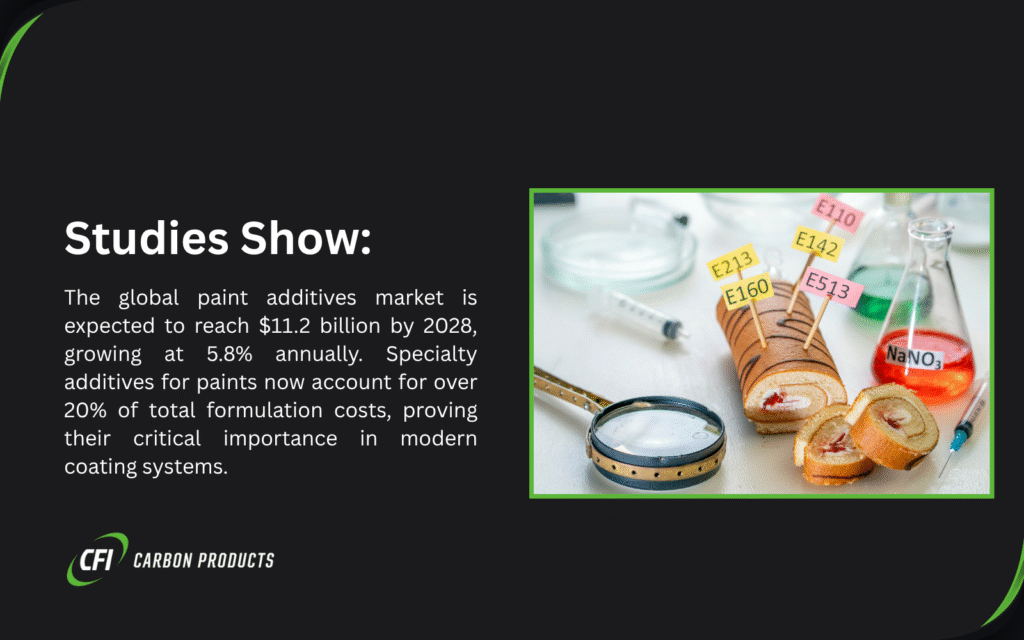
The Technical Foundation of Additives For Paints Science
The Technical Foundation of Additives For Paints Science
Additives for paints work as tiny helpers that change how coatings behave through specific chemical processes. These special ingredients solve problems that basic paint ingredients like pigments and binders can’t fix on their own.
Modern coating systems require multiple additive types to achieve performance specifications. The table below outlines primary additive categories and their specific functions:
| Additive Type | Core Function | Chemical Mechanism | Performance Impact |
| Rheological Additive | Viscosity control | Polymer chain interaction | Flow optimization, sag prevention |
| UV Stabilizers | Photodegradation protection | Free radical neutralization | Extended coating lifespan |
| PVC Additives | Property enhancement | Physical reinforcement | Mechanical strength improvement |
| Dispersants | Particle distribution | Surface tension modification | Color uniformity, stability |
| Antimicrobial Agents | Contamination prevention | Cell membrane disruption | Product preservation |
Global market analysis shows specialty additives account for 15-20% of formulation costs while delivering disproportionate performance value. This economic efficiency drives continuous innovation in additive technology development.
Carbon-Based Filler Technology in Paint Systems
Carbon black materials form a significant segment within paint additive technology. What is carbon black explains the fundamental characteristics that make these materials valuable across diverse coating applications.
Austin Black 325 represents advanced carbon-based filler technology through its unique production process from high-quality bituminous coal.
This organic filler offers properties compared to conventional carbon blacks, particularly its low specific gravity that reduces coating weight.
The following table compares Austin Black 325 properties with standard carbon black materials:
| Property Parameter | Austin Black 325 | Standard Carbon Black | Performance Advantage |
| Specific Gravity | 1.2-1.4 | 1.8-2.1 | 30% weight reduction |
| Particle Size | Optimized distribution | Variable distribution | Superior processability |
| Surface Chemistry | Modified surface | Standard surface | Enhanced compatibility |
| Production Process | Low-emission method | Conventional process | Environmental benefit |
| Cost Efficiency | Premium value | Standard pricing | Total system optimization |
These properties translate directly into manufacturing advantages and end-use performance benefits across multiple coating applications.
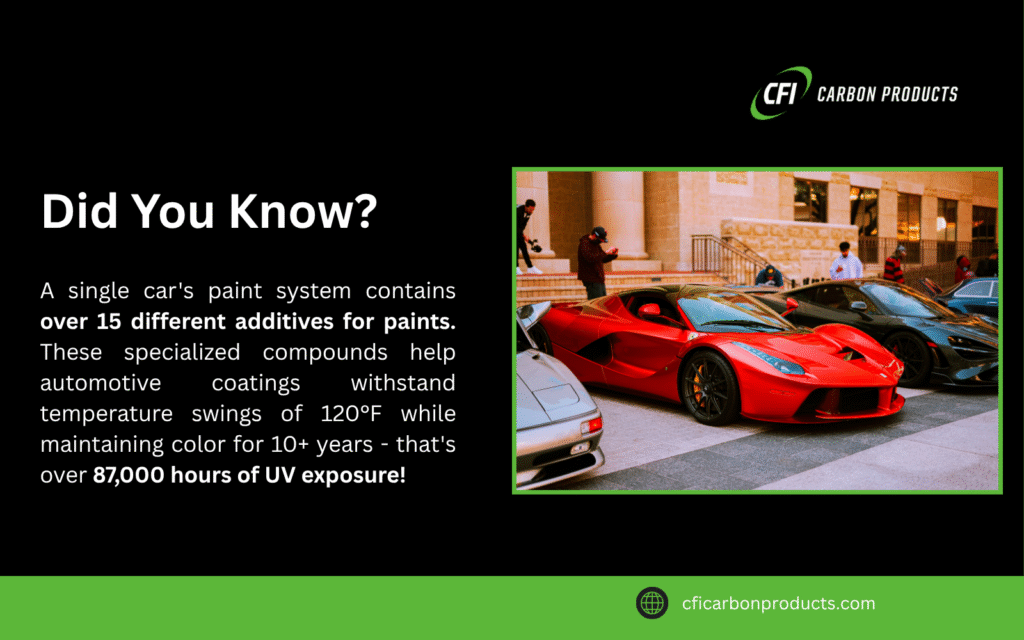
Measurable Performance Benefits from Advanced Additives
Modern additives for paints provide clear improvements in many performance areas. These improvements lead to cost savings and better customer satisfaction through longer coating life and less maintenance.
1. Mechanisms That Improve Durability
Additives for paints improve coating durability through various technical mechanisms.
UV stabilizers protect polymer matrices from photodegradation damage. The specialized fillers improve mechanical properties such as abrasion resistance and impact strength.
Carbon black for coatings demonstrates how carbon-based additives provide superior weathering resistance compared to conventional alternatives.
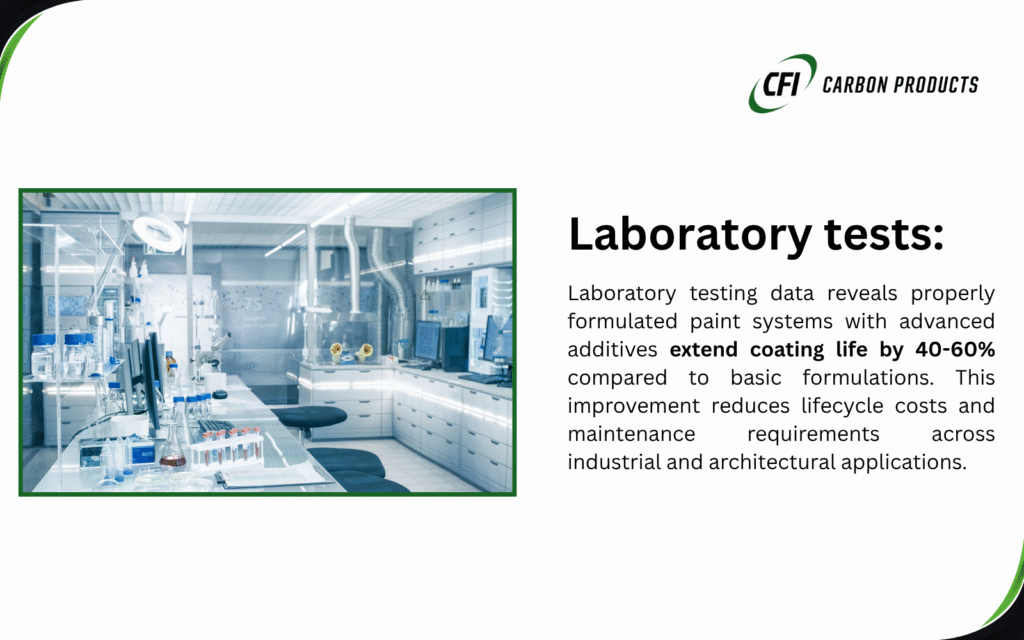
2. Making Manufacturing More Efficient
Plastic additives principles apply equally to paint systems, where proper additive selection reduces processing time and energy consumption. Powder coating additives and polymer processing additives follow similar optimization principles.
The table below shows specific processing improvements achieved with Austin Black 325 compared to standard rubber additives and plastic additives manufacturers’ solutions:
| Processing Parameter | Standard Filler | Austin Black 325 | Improvement Percentage |
| Grinding Time | 45 minutes | 34 minutes | 25% reduction |
| Energy Consumption | 100% baseline | 82% baseline | 18% reduction |
| Batch Consistency | ±5% variation | ±2% variation | 60% improvement |
| Mill Base Efficiency | Standard rate | Enhanced rate | 15% increase |
| Overall Cost Impact | Baseline cost | Reduced cost | 8-12% savings |
These processing advantages translate into significant manufacturing cost savings and improved product quality consistency.
Industry-Specific Additive Applications
Different industries require specialized additive solutions to meet unique performance requirements. Automotive applications demand additives that provide chip resistance and superior appearance.
1. Automotive Coating Requirements
Automotive paint systems represent the most demanding applications of additives for paints. These coatings must withstand extreme temperature variations, chemical exposure, and physical damage.
Additives for automotive coatings require careful selection to balance performance requirements with application constraints.
The following table outlines specific additive requirements for automotive applications:
| Performance Requirement | Additive Type | Technical Function | Test Standard |
| Chip Resistance | Impact modifiers | Energy absorption | ASTM D3170 |
| UV Protection | Stabilizer compounds | Photodegradation prevention | ASTM G154 |
| Chemical Resistance | Barrier additives | Molecular protection | ASTM D1308 |
| Temperature Stability | Heat stabilizers | Thermal protection | ASTM D2485 |
| Color Retention | Light stabilizers | Chromophore protection | ASTM D4587 |
Automotive additives for paints often combine several functions. Flow additives control how paint applies, while UV additives for paints prevent fading and chalking. Carbon fillers improve chip resistance and color quality.
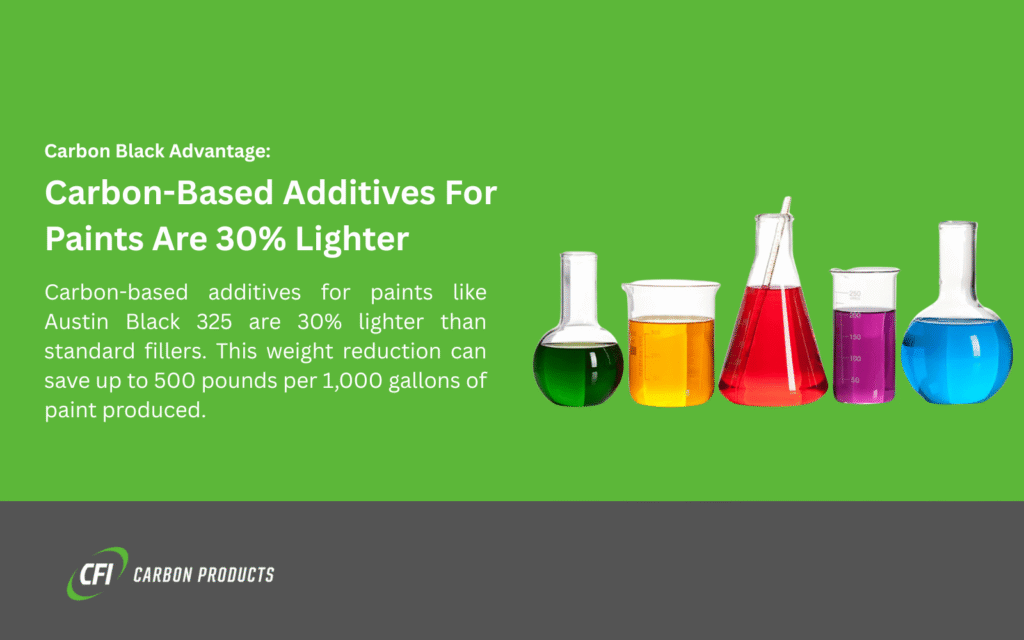
2. Architectural Paint System Requirements
Architectural coatings face different challenges, primarily related to long-term weathering resistance and aesthetic durability.
Paint additive for cabinets and other interior applications must provide protection against moisture, stains, and mechanical damage while maintaining appearance over extended periods.
Additives for wood coatings require special formulation considerations for substrate adhesion and moisture resistance.
This table shows additive requirements for architectural applications, including specialty additives for different surface types:
| Application Area | Primary Challenge | Additive Solution | Performance Metric |
| Exterior Walls | Weather exposure | UV stabilizers | 15+ year durability |
| Interior Surfaces | Stain resistance | Barrier coatings | 90%+ cleanability |
| High-Traffic Areas | Abrasion damage | Reinforcement fillers | 2x wear resistance |
| Moisture Areas | Water damage | Hydrophobic additives | 95%+ moisture resistance |
| Color-Critical Areas | Fade resistance | Light stabilizers | 5+ year color retention |
These solutions prove that environmental responsibility and performance excellence work together effectively.
UV additive for plastic applications demonstrates similar environmental benefits and maintains superior protection characteristics.
Technical Selection Criteria of Additives For Paints
Proper additive selection requires systematic evaluation of multiple factors such as compatibility, concentration levels, and interaction effects. Modern paint formulations demonstrate complexity that requires additive performance evaluation within complete system contexts.
1. Compatibility Assessment Methods
Additives for paints must demonstrate compatibility with all system components such as resins, pigments, and other additives. Incompatibility results in performance degradation, application problems, or coating defects.
Polymer additives principles guide compatibility testing and help predict potential problems. Polyurethane additives for paints need special attention for compatibility and curing processes.
The following table outlines systematic compatibility testing protocols:
| Test Category | Evaluation Method | Acceptance Criteria | Time Frame |
| Initial Compatibility | Visual inspection | No separation/precipitation | 24 hours |
| Thermal Stability | Heat aging test | <5% property change | 168 hours |
| Chemical Resistance | Solvent exposure | No degradation | 72 hours |
| Mechanical Properties | Tensile testing | ±10% baseline values | Standard test |
| Long-term Stability | Accelerated aging | Pass/fail criteria | 1000 hours |
These evaluation protocols identify potential problems before commercial implementation and help optimize additive concentrations for maximum benefit.
2. Concentration Optimization Strategies
Additive effectiveness often follows non-linear concentration relationships, where small concentration changes produce significant performance differences.
Insufficient additive levels fail to provide desired benefits, while excessive levels cause negative effects such as increased cost and potential performance degradation.
This concentration optimization table shows Austin Black 325 performance at different levels:
| Application Type | Concentration Range | Primary Benefit | Secondary Effects |
| Architectural Coatings | 2-4% | Weather protection | Cost optimization |
| Industrial Coatings | 4-6% | Durability enhancement | Processing improvement |
| Automotive Coatings | 3-5% | Appearance quality | Chip resistance |
| Specialty Coatings | 5-8% | Multi-functional benefits | Custom performance |
| High-Performance Systems | 6-8% | Maximum properties | Premium applications |
Austin Black 325 demonstrates excellent concentration efficiency, providing significant benefits at relatively low addition levels. Optimal levels are determined through systematic testing protocols that balance performance with cost considerations.
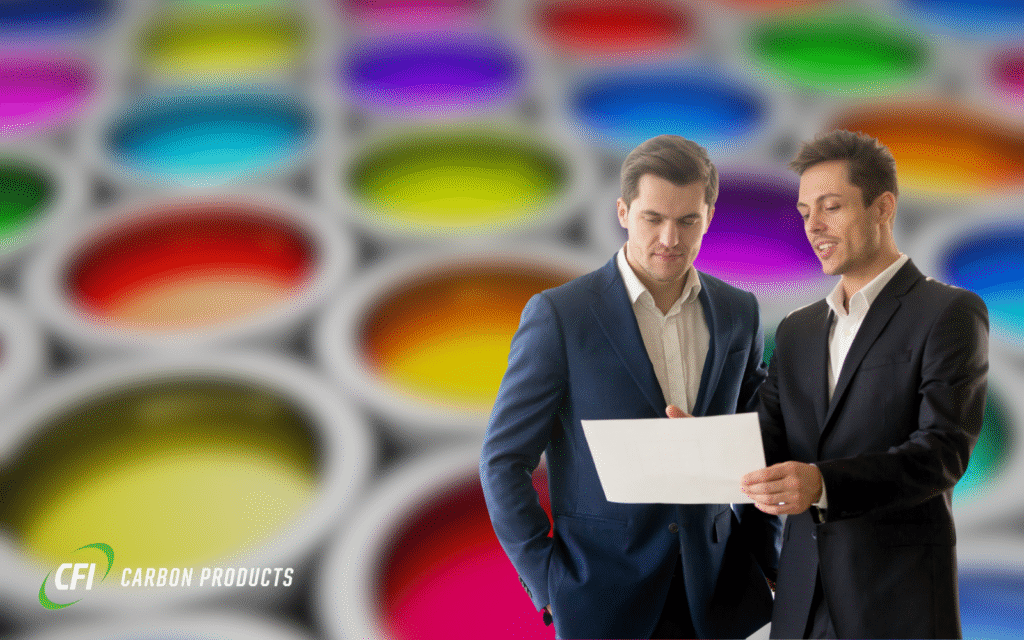
Quality Control and Testing Methodologies
Good quality control programs ensure consistent additive performance and help find potential problems before they affect production. Modern testing methods combine traditional techniques with advanced methods to provide complete additive evaluation.
1. Analytical Testing Methods
The table below shows comprehensive testing methods for paint additive evaluation:
| Test Method | Measured Parameter | Equipment Required | Analysis Time |
| Particle Size Analysis | Size distribution | Laser diffraction | 15 minutes |
| Surface Area Measurement | Specific surface area | BET analyzer | 4 hours |
| Chemical Composition | Elemental analysis | XRF spectroscopy | 30 minutes |
| Rheological Properties | Flow behavior | Rotational rheometer | 45 minutes |
| Thermal Analysis | Stability profile | DSC/TGA | 2 hours |
| Microscopy Examination | Morphology assessment | SEM imaging | 1 hour |
2. Performance Validation Protocols
Comprehensive performance validation programs evaluate additive effectiveness through both laboratory testing and field exposure studies.
These programs provide data necessary for product optimization and help establish recommended use levels for different applications.
The validation testing matrix includes:
| Validation Type | Test Duration | Environmental Conditions | Performance Metrics |
| Accelerated Weathering | 2000 hours | UV/moisture cycles | Color retention, gloss |
| Chemical Resistance | 30 days | Various solvents | Weight change, appearance |
| Mechanical Testing | Standard protocols | Ambient conditions | Tensile, impact strength |
| Thermal Cycling | 100 cycles | -40°C to +80°C | Adhesion, flexibility |
| Real-time Exposure | 12+ months | Outdoor conditions | All parameters |
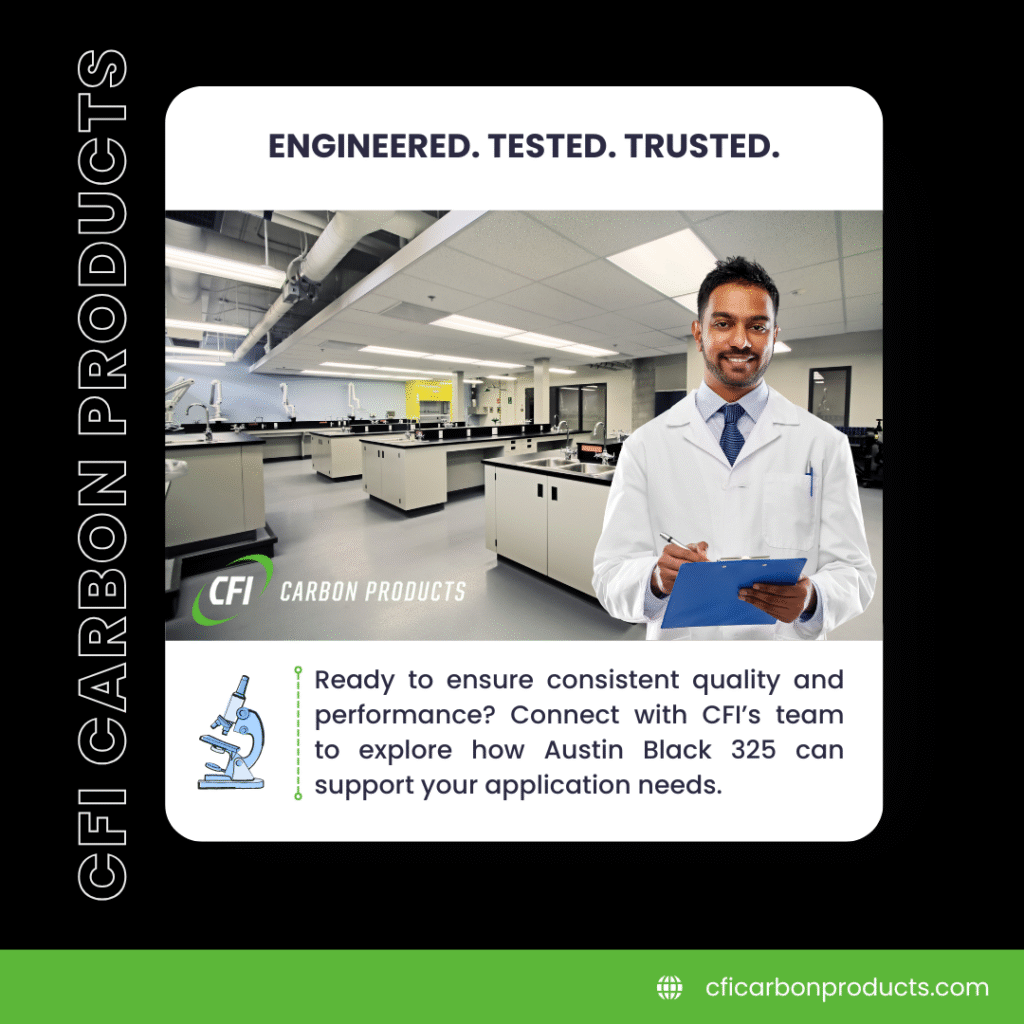
CFI Carbon Products maintains extensive testing facilities that evaluate Austin Black 325 performance across multiple application areas. This testing capability ensures consistent product quality and provides technical support for customer applications.
Environmental Impact and Sustainability Factors
Manufacturers and end-users seek solutions that provide excellent performance and minimize environmental impact, improved durability, and sustainable sourcing practices.
1. Sustainability Metrics
Austin Black 325 exemplifies sustainable additive technology through its low-emission production process and enhanced coating durability.
Extended coating life provided by this advanced filler reduces maintenance requirements and resource consumption over the coating lifecycle.
The sustainability comparison table shows environmental advantages:
| Environmental Factor | Conventional Additive | Austin Black 325 | Environmental Benefit |
| Production Emissions | High CO2 output | Low CO2 output | 40% emission reduction |
| Energy Consumption | Standard energy use | Optimized process | 25% energy savings |
| Coating Durability | 5-8 year life | 8-12 year life | 50% lifecycle extension |
| Maintenance Frequency | Regular repainting | Extended intervals | Resource conservation |
| Waste Generation | Higher waste stream | Reduced waste | 30% waste reduction |
Sustainability initiatives in additive production focus to reduce environmental impact and maintain performance standards. These efforts include process optimization, waste reduction, and development of renewable raw material sources.
Economic Analysis and Cost Optimization
Premium additives often provide superior value through improved processing efficiency, enhanced performance, and extended coating life.
1. Total Cost of Ownership Analysis
The following table shows comprehensive economic benefits achieved with Austin Black 325:
| Cost Category | Baseline System | Austin Black 325 System | Economic Advantage |
| Raw Material Costs | 100% baseline | 105% baseline | Premium material investment |
| Processing Costs | 100% baseline | 85% baseline | 15% manufacturing savings |
| Application Costs | 100% baseline | 95% baseline | 5% labor reduction |
| Maintenance Costs | 100% baseline | 60% baseline | 40% maintenance savings |
| Total Lifecycle Cost | 100% baseline | 82% baseline | 18% total cost reduction |
Advanced additives for paints save money beyond material costs. They cut manufacturing and long-term costs, often justifying higher prices.
Implementation Guidelines for Paint Additive Selection
Successful additive implementation requires systematic approaches that consider technical requirements, economic constraints, and application-specific demands. Proper implementation protocols make sure for optimal performance.
1. Implementation Success Factors
The implementation strategy table outlines critical success factors:
| Implementation Phase | Key Activities | Success Metrics | Timeline |
| Initial Assessment | Technical requirements definition | Specification completion | 1-2 weeks |
| Additive Selection | Compatibility testing | Performance validation | 2-4 weeks |
| Formulation Development | Optimization trials | Target property achievement | 4-6 weeks |
| Scale-up Testing | Production trials | Quality consistency | 2-3 weeks |
| Commercial Launch | Full production | Customer acceptance | Ongoing |
2. Technical Support Services
CFI Carbon Products provides comprehensive technical support through specialized services such as formula testing, lab sampling, and application optimization. This support helps customers achieve optimal results while minimizing development time and costs.
Technical support services include these key areas:
| Service Category | Specific Services | Deliverables | Value Proposition |
| Formulation Support | Recipe development | Optimized formulations | Faster market entry |
| Testing Services | Performance validation | Test reports | Risk reduction |
| Application Guidance | Process optimization | Best practices | Quality improvement |
| Problem Solving | Technical troubleshooting | Solutions | Production continuity |
| Regulatory Support | Compliance guidance | Documentation | Market access |
Essential Insights for Paint Manufacturing Success
Modern paint formulations depend on advanced additives for paints to achieve performance that basic components cannot provide alone. Proper additive selection requires the evaluation of technical needs, costs, and environmental factors.
Austin Black 325 represents advanced carbon-based additive technology. It provides superior performance through optimized particles and sustainable production. This filler shows how innovative additives for paints deliver multiple benefits while supporting environmental responsibility.
Successful implementation requires systematic evaluation and testing. Technical support helps ensure optimal results while minimizing problems.
Future additives for paint technology promise continued advancement. This includes nanotechnology, multifunctional additives, and digital tools. These developments will enhance coating performance while supporting sustainability.

Trust CFI Carbon Products for High-Performance Additives For Paints
CFI Carbon Products brings over 35 years of experience in manufacturing specialized filler materials for rubber, plastics, silicone, and coatings industries.
From formula testing to global distribution, CFI controls the entire process while maintaining strict quality standards and environmental responsibility.
Our Austin Black 325 and comprehensive services help manufacturers reduce costs, improve product performance, and meet sustainability goals across multiple industries.
Contact CFI Carbon Products today to discuss your paint additive needs and discover how our proven solutions can enhance your manufacturing operations.

